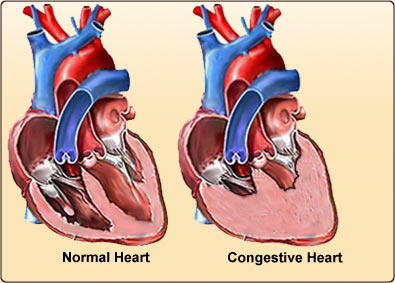Saving Your Heart From Congestive Heart Failure
Congestive heart failure (CHF)is when the heart is weakened and is unable to pump blood through the body at a normal rate. It does not mean that the heart has stopped working but rather, it cannot supply the body with enough oxygen and other nutrients to function properly.

Different types of heart failure are
Diagnosis may begin with the observation of the mentioned symptoms and should be confirmed through an evaluation by a physician. The evaluation may include a physical examination, ECG, chest x-rays, Heart CT scan, MRI of the heart, echocardiogram, angiography (x-ray of the heart and blood vessels using a radiopaque contrast medium), heart catheterization, nuclear heart scan, and blood or urine analysis.
Need to learn more about Congestive Heart Failure? Be sure to check out which contains in-depth information on congestive heart failure prognosis
www.heart-disease-treatments.com/Heart-Failure.php. Causes, diagnosis, symptoms, treatment and much more.
Surgical and other options:

Different types of heart failure are
Left-sided failure: It is the most common form of heart failure in which the heart is unable to pump enough oxygen-rich blood to the body. In this condition fluid may back up in the lungs, causing shortness of breath.
Right-sided heart failure: This happens when the heart does not fill with enough blood and sometimes fluid may back up into the abdomen, causing the legs and feet to swell.
Systolic: It indicates a pumping problem in which the left ventricle doesn't contract vigorously.
Diastolic: The left ventricle is unable to relax or fill fully, indicating a filling problem.
Symptoms of heart failure are
Fatigue and weakness
Swelling in your legs, ankles and feet
Palpitations
Persistent cough or wheezing
Swelling of your abdomen
Lack of appetite and nausea
Decreased alertness
Chest pain
Diagnosis may begin with the observation of the mentioned symptoms and should be confirmed through an evaluation by a physician. The evaluation may include a physical examination, ECG, chest x-rays, Heart CT scan, MRI of the heart, echocardiogram, angiography (x-ray of the heart and blood vessels using a radiopaque contrast medium), heart catheterization, nuclear heart scan, and blood or urine analysis.
Need to learn more about Congestive Heart Failure? Be sure to check out which contains in-depth information on congestive heart failure prognosis
www.heart-disease-treatments.com/Heart-Failure.php. Causes, diagnosis, symptoms, treatment and much more.
Surgical and other options:
Coronary bypass surgery: In this procedure a graft is created to bypass blocked coronary arteries using a vessel from another part of the body. This allows blood to flow around the blocked or narrowed coronary artery.
Heart valve repair or replacement: When a faulty heart valve causes heart failure then the faulty valve is repaired or replaced using this procedure.
Implantable cardioverter-defibrillator (ICD): It is a small device which is placed under the skin just below the collarbone to send electrical signals to the heart when it goes very fast. It is also helpful in regulating heartbeat.
Cardiac resynchronization therapy (CRT) / biventricular pacing: A biventricular pacemaker sends timed electrical impulses to both the left and right ventricles, so that they pump in a more efficient, coordinated manner.
Heart pumps (left ventricular assist devices or LVADs): These devices are implanted into the abdomen or chest and attached to a weakened heart to help it pump.
Heart transplant: In cases of severe heart failure when surgery and medications don't help, then the diseased heart is replaced with a healthy donor heart. Heart transplants can improve the survival and quality of life of people with severe heart failure.
